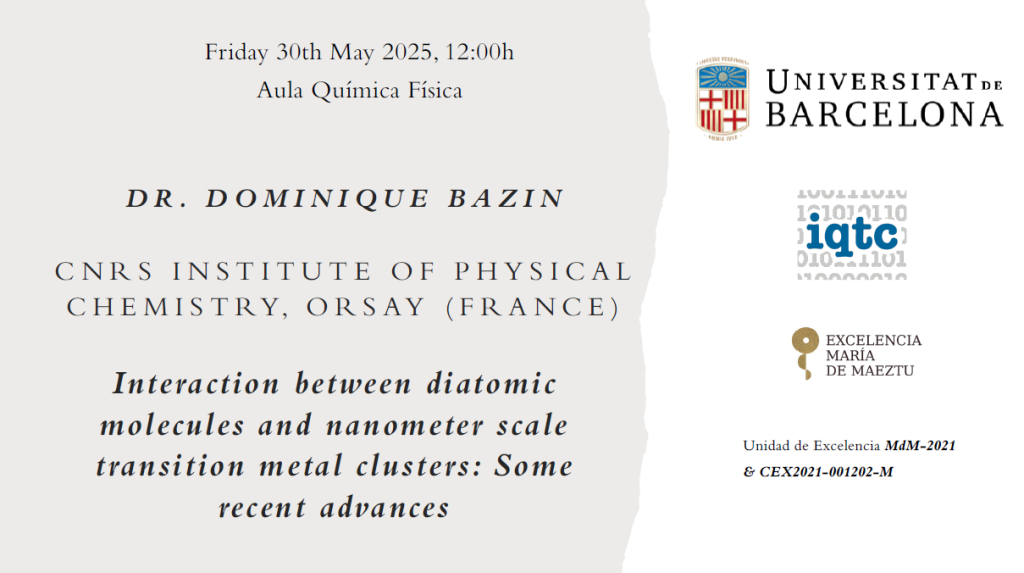IQTC Seminar: Dominique Bazin
Interaction between diatomic molecules and nanometer scale transition metal clusters: Some recent advances
Friday May 30th 2025, 12:00h
Aula de Química Física

Metallic clusters, characterized by well-defined atom counts and unique electronic structures, provide an invaluable platform for exploring catalytic behavior beyond bulk metals and extended surfaces. This lecture examines the atomic-scale interplay between cohesive energy, adsorption mechanisms, and catalytic performance, with a focus on nitrogen oxide (NO) adsorption and its implications for bimetallic catalyst design. By combining experimental data with density functional theory (DFT) simulations, we establish a direct relationship between adsorption modes (dissociative versus molecular) and the stability of nanocluster-supported metal catalysts. We will see that the number of d electrons is a descriptor for the interaction between molecules such NO as well as N2,CO or O2. The complete set of results demonstrates that cohesive energy trends across bulk, metallic surfaces, and nanoclusters follow similar patterns, providing a framework for predicting catalytic behavior based on atomic-level interactions. This work also refines the Sabatier principle for nanoscale systems, particularly for bimetallic catalysts, and proposes a new strategy for optimizing catalytic reactions in industrial applications such as NOx reduction, Haber-Bosch, and Fischer-Tropsch processes.
Related publications :- D. Bazin et al., New opportunities to understand the properties of NSMC through S.R. studies and theor. calculations, Rec. Res. Dev. in Phys. Chemistry 3(1999)387.
– D. Bazin et al., New trends in HC processes on metallic clusters from S.R. and theoretical studies, App. Surf. Sc. 164(2000)140.
– D. Bazin, Solid state concepts to understand catalysis using NSMC, Topics in Cat. 18(2002)79.
– D. Bazin, Solid State Physics and S.R. Techniques to understand H.C. , in « Nanotechnology in catalysis », Vol 2, Ed. Zhou, Hermans, Somorjai, Ed. Kluwer, 2004.
– D. Bazin et al.,Combining solid state physics concepts and X.A.S. to understand DeNOx catalysis, Oil & Gas Science & Technology – Rev. IFP, 61-5(2006)677.
– D. Bazin, Bridging nanoscience and surface science to understand heterogeneous catalysis, Macromolecular Res. 14-2(2006)230.
– D. Bazin et al., Reactivity and catalysis by nanoalloys in “Nanoalloys: From Fundamentals to Emergent Applications”, Ed. F. Calvo, Ed. Newnes, 2013.
– D. Bazin, François Garin: Pioneer work in catalysis through S.R. , C. R. Chimie 17(2014)615.
– F. Tielens et al., On the way of understanding the behavior of NSMC toward the adsorption of CO and NO molecules, C. R. Chimie 21(2018)174.
– I. Oguz et al., Predicting the activity of NSMC denox catalysts, J. Phys. Chem. C. 123(2019)20314.
– J. Vekeman et al. Synergistic effects in the activity of NSMC Pt12 M (M =Ir, Ru, Rh) for NO dissociation, Chem. Phys. Chem. 23(2022)e202200374.
– D. Bazin et al., Nanostructured materials and heterogeneous catalysis: a succinct review regarding DeNox catalysis, C.R. Chimie 25-S3(2022)237.
– J.L. Nunez et al., Understanding the atomistic behavior of small molecules (O2 and N2) on monometallic M13 nanoparticles, Cat. Today 445(2025)115051.
Biography – ORCID
Dominique Bazin, Research Director at the CNRS Institute of Physical Chemistry in Orsay (Ile de France), studied solid state physics at the Université Paris XI, Orsay, where he obtained his 3eme Cycle thesis in 1985 on the characterization of nanometer scale metallic clusters. He was appointed CNRS researcher in 1985 in the solid state physics group at LURE (Laboratoire pour l’Utilisation du Rayonnement Electromagnétique, Laboratory for Electromagnetic Radiation Applications) to develop in situ X-ray absorption spectroscopy characterization of supported nanometer scale metallic clusters used in reforming, Fischer-Tropsch, and postcombustion, industrial processes. In 1991, he undertook a postdoctoral fellowship in Professor Dale Sayers’ group in Raleigh at NCSU (North Carolina State University) for 14 months to develop AWAXS (Anomalous Wide Angle X-ray Scattering) data analysis. He was appointed director at CNRS in 2001, and in 2004 moved to LPS (laboratoire de Physique des Solides), Université Paris XI in Orsay, to develop the characterisation of pathological calcifications, PCs, such as kidney stones. To characterise the first steps in the pathogenesis process and to develop new diagnostic tools, several techniques including scanning electron microscopy, Fourier transform Infrared spectroscopy, as well as techniques specific to synchrotron radiation such as XAS or X-ray Scattering have been applied. In 2012 he moved to LCMCP (Laboratoire de Chimie de la Matière Condensée de Paris) at the Collège de France to develop the application of soft chemistry concepts, developed by Prof. J. Livage, to advance understanding of PC physicochemistry. Finally in 2018 he moved to the Institute of Physical Chemistry at Université Paris Saclay to develop PC characterization using nanoIR spectroscopies such as AFMIR (a combination of atomic force microscopy and IR spectroscopy) and OPTIR (Optical PhotoThermal IR). His current research interests include the different kinds of PC occurring in kidney, prostate, breast, thyroid, and skin. Rationalising this diversity of origin is of primary importance in understanding details of the relevant pathogenic mechanisms and their relationship to either homogeneous or heterogeneous nucleation. All this research is underpinned by close collaboration with clinicians, resulting in several new medical diagnostic tools, for example in primary hyperoxaluria and kidney infection diseases.
